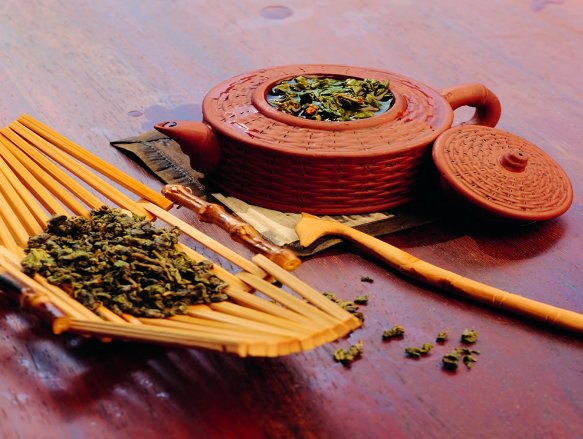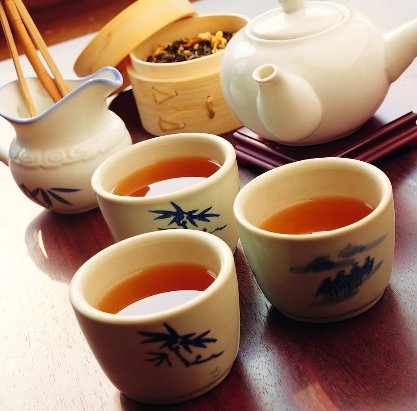普洱 Pu-erh Tea
 普洱茶是以云南省一定区域内的云南大叶种晒青毛茶为原料,经过后发酵加工成的散茶和紧压茶。其外形色泽褐红;内质汤色红浓明亮,香气独特沉香,滋味醇厚回甘,叶底褐红。 普洱茶的產地因在清朝时屬雲南省普洱府(今普洱市,2007年前为思茅市),所以以此泛稱之。實際上,現在被稱為滇普洱茶泛指中國雲南地區生產的一种茶叶。
普洱茶是以云南省一定区域内的云南大叶种晒青毛茶为原料,经过后发酵加工成的散茶和紧压茶。其外形色泽褐红;内质汤色红浓明亮,香气独特沉香,滋味醇厚回甘,叶底褐红。 普洱茶的產地因在清朝时屬雲南省普洱府(今普洱市,2007年前为思茅市),所以以此泛稱之。實際上,現在被稱為滇普洱茶泛指中國雲南地區生產的一种茶叶。
明朝時普洱茶稱普茶,明成祖朱棣曾下令取消天下龙团和凤团等緊壓茶,但不是黑茶是绿茶;在邊境的雲南,這種古稱”團茶” 的緊壓茶製作工藝保存下來 。
普洱茶自古被認為有治理腸胃、解油膩的功能。主食為牛羊肉及澱粉(青稞)的西藏人,據說只要沒有茶,就會生病。現代中國、日本及法國的臨床實驗均顯示普洱茶有降低胆固醇和血脂的功效,對心血管疾病保健很有幫助。
由於普洱茶「渥堆」工藝向來被視為不傳之秘,所以造成「黑洞」,让初次接触的人容易买到不合格的普洱茶;
Pu-erh or Pu’er tea (pǔ’ěr chá) is a variety of fermented dark tea produced in Yunnan province, China.[ Fermentation is a tea production style in which the tea leaves undergo microbial fermentation and oxidation after they are dried and rolled. This process is a Chinese specialty and produces tea known as Hei Cha (黑茶), commonly translated as dark, or black tea (this type of tea is completely different from what in West is known as “black tea”, which in China is called “red tea” 红茶). The most famous variety of this category of tea is Pu-erh from Yunnan Province, named after the trading post for dark tea during imperial China.
Pu’er traditionally begins as a raw product known as “rough” Mao Cha (毛茶) and can be sold in this form or pressed into a number of shapes and sold as “raw” Sheng Cha (生茶). Both of these forms then undergo the complex process of gradual fermentation and maturation with time. The Wo Dui process (渥堆) developed in the mid-1970s by the Menghai and Kunming Tea Factories created a new type of pu-erh tea, whose legitimacy is disputed by some traditionalists. This process involves an accelerated fermentation into “ripe” Shou Cha (熟茶) which is then stored loose or pressed into various shapes. All types of pu-erh can be stored to mature before consumption, which is why it is commonly labelled with year and region of production.
鐵觀音是烏龍茶的一種,原產於福建安溪縣。铁观音属介于绿茶和红茶之间的半发酵茶。鐵觀音原是茶樹品種名,由於它適制烏龍茶,其烏龍茶成品遂亦名為鐵觀音。所謂鐵觀音茶即以鐵觀音品種茶樹製成的烏龍茶,亦有一种说法称“铁观音”名称乃乾隆皇帝所赐。在台灣,鐵觀音茶則是指一種以鐵觀音茶特定製法製成的烏龍茶,所以台灣鐵觀音茶的原料,可以是鐵觀音品種茶樹的芽葉,也可以不是鐵觀音品種茶樹的芽葉。
Thih-koan-im; literally “Iron Guanyin”) is a premium variety of Chinese oolong tea originated in the 19th century in Anxi in Fujian province. Tieguanyin produced in different areas of Anxi have different gastronomic characteristics.[2] Production has since extended to many regions even outside of China.


